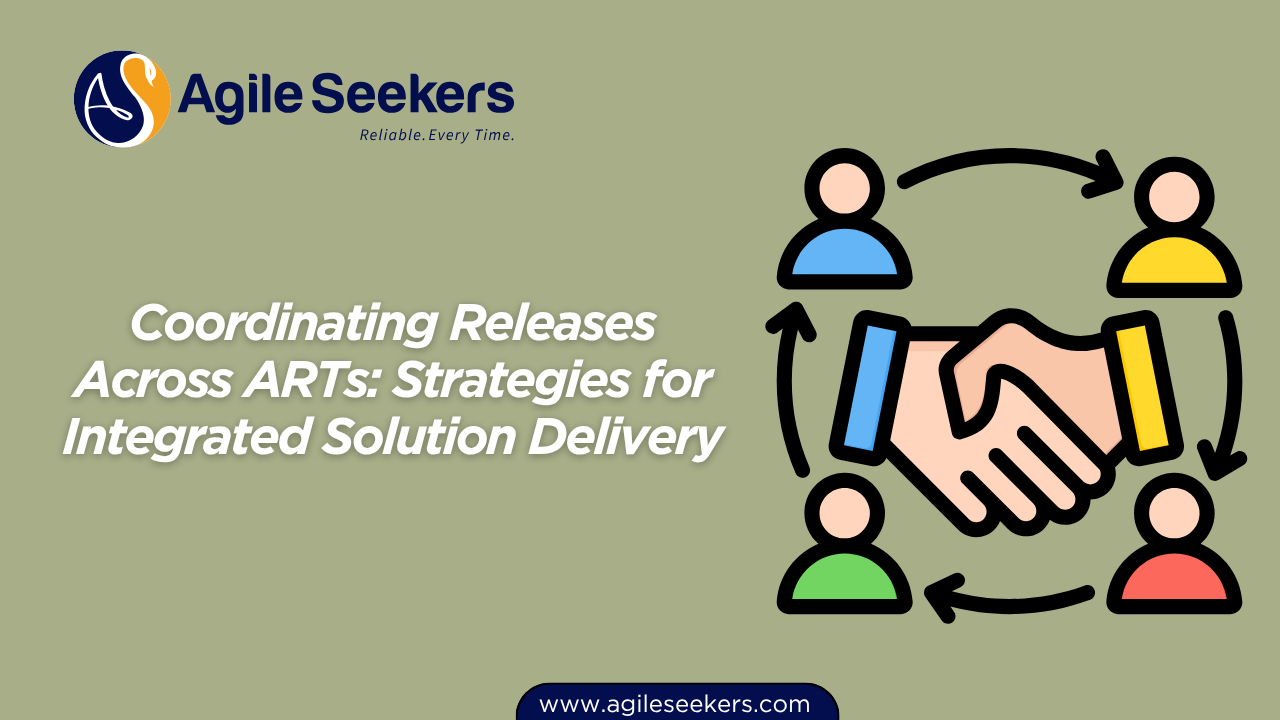Coordinating Releases Across ARTs: Strategies for Integrated Solution Delivery

When multiple Agile Release Trains (ARTs) contribute to a single, integrated solution, aligning their release schedules and delivery objectives becomes critical. Without structured coordination, these ARTs can fall into local optimization traps, dependency deadlocks, or fragmented releases that delay business value.
This post explores actionable strategies to coordinate releases across ARTs for cohesive solution delivery in a Scaled Agile Framework (SAFe®) environment.
Why Coordinated Releases Matter in Large-Scale Delivery
Multiple ARTs often work on different capabilities of a larger solution — for example, a telecom platform where one ART develops backend services, another handles mobile apps, and a third manages infrastructure. If these ARTs release on disconnected timelines or lack dependency awareness, the system fails to function as a whole.
Coordinated releases ensure:
-
System-level integrity
-
Predictable business outcomes
-
Efficient use of resources across trains
-
Reduced downstream rework and integration failures
This challenge is amplified in SAFe’s Large Solution level, where Solution Trains orchestrate delivery across multiple ARTs and Suppliers.
1. Use Solution Roadmaps to Set Shared Direction
The first step toward coordination is aligning on Solution Roadmaps. This long-term view links capabilities, enablers, and business epics across ARTs and suppliers. A well-crafted roadmap identifies synchronization points and clarifies which ARTs deliver what and when.
This roadmap isn't static — it evolves based on feedback from each Program Increment (PI). It serves as a guiding compass across teams.
🧭 Related: Learn how to build strategic vision with Leading SAFe Certification Training
2. Establish a Shared PI Cadence
While each ART operates with a regular Program Increment (PI) cadence, aligning the PI schedule across ARTs is essential for integrated release planning. This enables:
-
Shared PI Planning sessions
-
Unified System Demos
-
Coordinated Inspect and Adapt (I&A) events
-
Smooth integration of capabilities and features
The cadence sync ensures cross-train transparency and predictability without sacrificing agility.
🔄 Learn how PI cadence supports release coordination in the SAFe Scrum Master Certification
3. Align via Solution Train Roles and Events
At the Large Solution level, SAFe introduces specialized roles and events to manage dependencies and system complexity:
| Role/Event | Purpose |
|---|---|
| Solution Train Engineer | Facilitates coordination across ARTs |
| Solution Management | Prioritizes capabilities across trains |
| Solution Architect/Engineer | Aligns architectural runway and technical integration |
| Pre- and Post-PI Planning | Synchronizes scope and objectives across ARTs |
| Solution Demo | Validates integrated solution incrementally |
These roles mirror team-level counterparts but operate at a system scale.
📌 If you're driving coordination across ARTs, explore the SAFe Release Train Engineer Certification
4. Coordinate Backlogs with Capabilities
In multi-ART environments, Capabilities span across multiple trains and must be broken down into Features aligned with each ART’s delivery scope.
To prevent misalignment:
-
Ensure that capabilities flow down from the Solution Backlog into ART-level backlogs
-
Use dependency mapping to sequence work
-
Sync Feature delivery using the Program Board during PI Planning
This helps ensure that disparate features converge into a working capability in the solution demo.
📘 Understand how capabilities decompose into features with the SAFe POPM Certification
5. Leverage DevOps and CI/CD Across ARTs
Integrated delivery depends on more than planning — it requires cross-ART technical enablement through:
-
Shared CI/CD pipelines
-
Common environments and tooling
-
Consistent definition of done
-
Automated integration and regression testing
With DevOps at the heart of system delivery, ARTs can confidently release smaller increments and validate integration early.
🔗 See SAFe’s DevOps health radar for diagnostic and improvement areas.
6. Visualize and Manage Cross-ART Dependencies
Dependencies are a leading cause of delay in integrated systems. To manage them effectively:
-
Use a Program Board across ARTs
-
Implement Dependency Heatmaps
-
Schedule regular ART Syncs with key stakeholders (SMs, RTEs, POs)
-
Apply Weighted Shortest Job First (WSJF) with dependency impact as a factor
These tools provide visibility and prompt early resolution, which is critical in synchronized environments.
🧠 Get deeper facilitation skills for this by pursuing the SAFe Advanced Scrum Master Certification Training
7. System Demos: The Integration Feedback Loop
System Demos at the solution level offer early, valuable feedback across ART boundaries. These demos should include:
-
Real data
-
End-to-end workflows
-
Cross-ART features integrated into user journeys
This feedback validates both business alignment and technical correctness long before a release.
📅 Learn how to maximize the effectiveness of system demos in the SAFe Scrum Master Certification
8. Handle Solution-Level Risks Transparently
Releases can derail due to unmanaged risk. Regular ROAMing (Resolved, Owned, Accepted, Mitigated) risks across ARTs through a shared Program Risk Board is essential. The Solution Train Engineer should surface risks that span ARTs early and help teams align on resolution paths.
For example:
-
Legal or compliance risks
-
Shared infrastructure readiness
-
Feature toggles and staging complexity
A structured risk-handling cadence avoids surprises at release time.
9. Release on Demand with Milestone Clarity
Even in coordinated releases, not everything must go live together. ARTs should adopt a Release on Demand strategy with:
-
Clear milestones for synchronization
-
Decoupled feature toggles
-
Progressive deployment strategies
This supports fast feedback and business agility, without sacrificing integrated quality.
Final Thoughts
Coordinating releases across ARTs is not just about timeline alignment — it's about aligning value, quality, people, and system thinking. Whether you're a Scrum Master, Product Manager, or RTE, your role in this coordination defines whether the business sees fragmented outputs or integrated solutions.
By using SAFe’s structured approach — combining cadence, roles, architecture, and DevOps — organizations can scale with confidence and deliver unified solutions to the market.
🔍 Interested in leading enterprise-wide transformations? Start with Leading SAFe Certification Training
Also read - Cadence vs Synchronization in ARTs
Also see - The Hidden Role of Architecture in ART Flow and PI Success




















